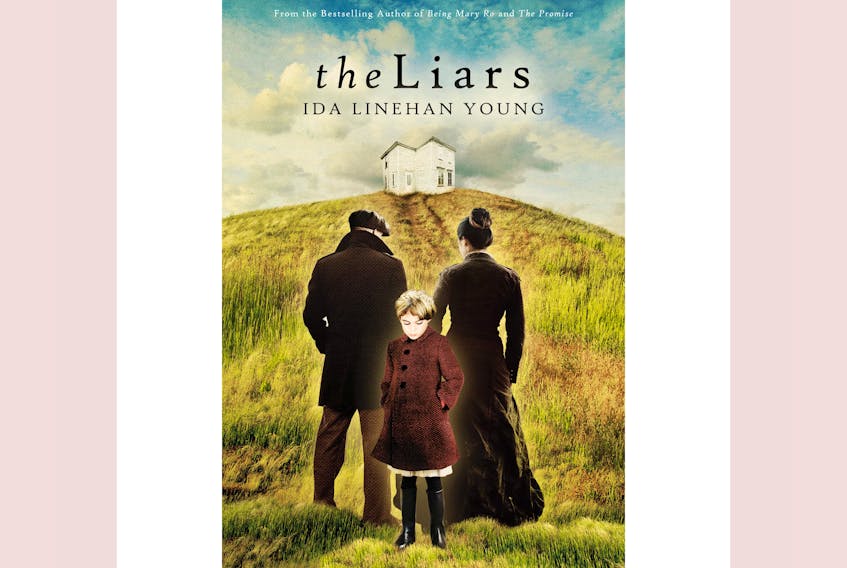“The Liars” is Ida Linehan Young’s third novel in her inter-linked series, characters working and dreaming, struggling and yearning in Newfoundland in the late 19th century.
This one centres on Alice and John MacDonald, who were introduced at the end of “The Promise.”

On the surface, they are an ordinary, if slightly withdrawn, married couple, doting on their daughter, Beatrice, going about their lives in Holyrood, Conception Bay, as they have for years. But in actuality they are, as the title implies, liars.
For starters, neither John nor Alice are their real names, though that is what they tell their neighbours and indeed how they introduced themselves to each other. And Beatrice is not their daughter, although they both do love her and want to protect her. In fact it’s that instinct that upends their lives at the beginning of the story.
An item appears in the “Harbour Grace Standard,” headlined “Prisoner Escapes.”
An accused murderer, being brought from Nain to Brigus, bolted from custody in Salmon Cove and is now a fugitive. John hears the news at the local store and conveys the bad tidings to Alice. They are both sure it is a man named Ezra, a dreaded figure from their shared past.
At first John is adamant they’ll simply hold firm and lay low. “We do nothing. Nobody knows where we are. We left all that far away.”
But, after their initial shock, their main concern is the child. “If it weren’t for Beatrice, they would have stared at changing seasons through the window of the house. Even if staying hidden was probably best, both he and Alice wanted more for Beatrice. They wanted her to be schooled. She was their miracle in all this … It was the child who stopped the running.”
John goes to meet Beatrice at the schoolyard, and by the time they have walked home he has a new plan. They will take the train to St. John’s, and meet with a lawyer.
As they busy themselves for their trip, John and Alice’s thoughts turn back to years before. John, abandoned by his family when his mother remarried, lived on the streets of St. John’s, making a few pennies for odd jobs when he could, and stealing food when he couldn’t. “That was the way things were. You grew up on the street, or you didn’t. What happened if you were lucky enough to grow up was a mystery.”
But then John has some good luck. First, he meets Lavinia, a young, dark-haired servant girl. Some young ruffians accost her as she tries to make her way back to her employer with a basket of bread; she doesn’t make it easy for them; John intercedes (they are his friends after all); and he and Lavinia start walking out.
And he also helps a young fellow who’s been robbed and beaten, assisting him from a Duckworth Street alley to his home in Rabbittown. Unexpectedly, his family takes John in, and he has not just a safe place to sleep but employment prospects. Soon he’s signing on as a seaman, saving for the house he and Lavinia can call their own. But dark fate intervenes, and a cascade of misadventure brings John to Labrador, living as a near recluse and surviving as a hunter and trapper.
Alice, meanwhile, also in Labrador, is a young married woman whose unexpected attraction to an older man proves far from harmless. Soon she is running for her life.
Brought back to their present dilemma, the lawyer they are journeying to see connects them with the major figures from “The Promise” — Erith and Danol. That book ended on their wedding day, which was something of a cliff-hanger.
Now they come into, or come back into, John and Alice’s sphere, with major repercussions all round.
“The Liars,” like “The Promise” and “Being Mary Ro” before is, is very melodramatic. That’s not a criticism, just an assessment of the tone.
Events move fast, stakes are high, and characters are often struck dumb with fear or fleeing this or that situation in terror. Linehan Young likes to keep things moving.
She also does her research. The previous books were largely set around her own home community of North Harbour, but background here expands to the Labrador coastline and interior, and the details of that land and settlements are nicely leavened in.
An “Afterword” also explores research backing other aspects of the plot.
Each of the books, by the way, is structured as a stand-alone read — but it’s fun to note how people crisscross and carry through each other’s distinct fortunes.
Joan Sullivan is editor of Newfoundland Quarterly magazine. She reviews both fiction and non-fiction for The Telegram.









